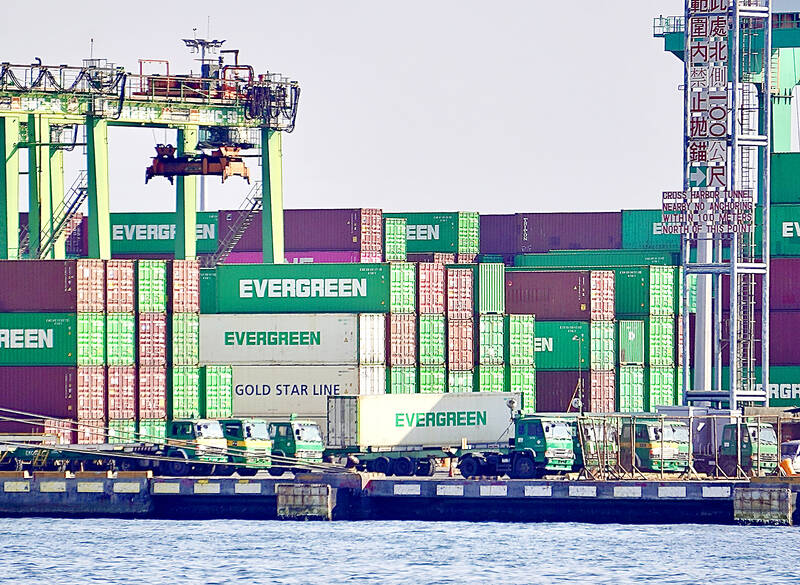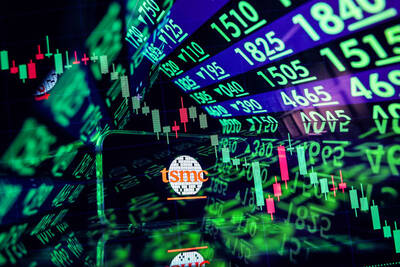The government’s business climate monitor last month flashed “yellow-red” light for the first time in two years, as strong industrial production, increasing imports of machinery equipment, robust domestic commercial activities and stock investments boosted the momentum of local businesses, the National Development Council said yesterday.
Prior to last month, the business climate monitor had maintained a “green” signal for three consecutive months.
The council measures the nation’s economic situation using a five-color system, with “blue” signaling a recession, “green” suggesting steady growth and “red” indicating a boom. “Yellow-red” reflects a slight boom, while “yellow-blue” shows sluggishness.

Photo: CNA
The total score of the monitor’s composite index rose four points from the previous month to 35, indicating steady growth for six months in a row, the council said in a report.
Meanwhile, the index of leading indicators, which gauges the economy’s direction in the next six months, moved up by 0.5 percent month-on-month to 102.09, rising for the seventh consecutive month, it said.
The index of coincident indicators, which tracks the current pace of economic activity, climbed 0.93 percent to 102.82, increasing for the 13th consecutive month, the council said.
“Benefiting from the growing demand for artificial intelligence and other tech applications, indicators such as industrial production, machinery and electrical equipment imports have turned to flashing red. Coupled with continued advancement in the leading and coincident indicators, the domestic economy is steadily recovering,” the council said.
Of the composite index’s nine components, the subindices on imports of capital equipment and sales of retail, wholesale and food and beverage services increased by two points each and changed from “green” the previous month to “red,” the report said.
The subindex on industrial production rose by one point, going from “yellow-red” a month earlier to “red,” while the subindex on manufacturing sales increased by one point, changing from “green” to “yellow-red, it said.
However, customs-cleared exports decreased by two points and flashed “green,” compared with “red” a month prior, the report said.
There were no changes in the signals of the other four subindices, including money supply, the TAIEX, non-agricultural employment and sentiment of the manufacturing sector, the report said.
Looking ahead, the council expects exports to continue showing steady growth, on the recovery of global trade and growing opportunities linked to emerging applications related to artificial intelligence.
It also said it expects domestic investment to continue gathering steam thanks to demand for advanced technologies, digital transformation and net zero carbon emissions, in addition to government projects for public works.
Meanwhile, private consumption is expected to retain strong momentum on the back of stable employment, higher minimum wages, a vibrant stock market and more government subsidies for housing and education, it said.
“However, uncertainties such as potential interest rate cuts in major economies, continued geopolitical risks and the intensifying rivalry between the US and China still exist, and their future developments deserve close observation,” the council said.

Taiwan Semiconductor Manufacturing Co (TSMC, 台積電) last week recorded an increase in the number of shareholders to the highest in almost eight months, despite its share price falling 3.38 percent from the previous week, Taiwan Stock Exchange data released on Saturday showed. As of Friday, TSMC had 1.88 million shareholders, the most since the week of April 25 and an increase of 31,870 from the previous week, the data showed. The number of shareholders jumped despite a drop of NT$50 (US$1.59), or 3.38 percent, in TSMC’s share price from a week earlier to NT$1,430, as investors took profits from their earlier gains

In a high-security Shenzhen laboratory, Chinese scientists have built what Washington has spent years trying to prevent: a prototype of a machine capable of producing the cutting-edge semiconductor chips that power artificial intelligence (AI), smartphones and weapons central to Western military dominance, Reuters has learned. Completed early this year and undergoing testing, the prototype fills nearly an entire factory floor. It was built by a team of former engineers from Dutch semiconductor giant ASML who reverse-engineered the company’s extreme ultraviolet lithography (EUV) machines, according to two people with knowledge of the project. EUV machines sit at the heart of a technological Cold

TAIWAN VALUE CHAIN: Foxtron is to fully own Luxgen following the transaction and it plans to launch a new electric model, the Foxtron Bria, in Taiwan next year Yulon Motor Co (裕隆汽車) yesterday said that its board of directors approved the disposal of its electric vehicle (EV) unit, Luxgen Motor Co (納智捷汽車), to Foxtron Vehicle Technologies Co (鴻華先進) for NT$787.6 million (US$24.98 million). Foxtron, a half-half joint venture between Yulon affiliate Hua-Chuang Automobile Information Technical Center Co (華創車電) and Hon Hai Precision Industry Co (鴻海精密), expects to wrap up the deal in the first quarter of next year. Foxtron would fully own Luxgen following the transaction, including five car distributing companies, outlets and all employees. The deal is subject to the approval of the Fair Trade Commission, Foxtron said. “Foxtron will be

INFLATION CONSIDERATION: The BOJ governor said that it would ‘keep making appropriate decisions’ and would adjust depending on the economy and prices The Bank of Japan (BOJ) yesterday raised its benchmark interest rate to the highest in 30 years and said more increases are in the pipeline if conditions allow, in a sign of growing conviction that it can attain the stable inflation target it has pursued for more than a decade. Bank of Japan Governor Kazuo Ueda’s policy board increased the rate by 0.2 percentage points to 0.75 percent, in a unanimous decision, the bank said in a statement. The central bank cited the rising likelihood of its economic outlook being realized. The rate change was expected by all 50 economists surveyed by Bloomberg. The